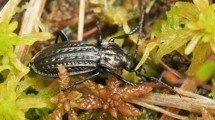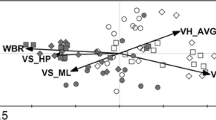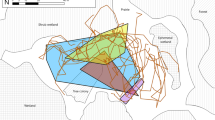Abstract
Biota dependant on early seral stages or frequently disturbed habitats belong to the most rapidly declining components of European biodiversity. This is also the case for Carabus nitens, which is threatened across Western and Central Europe. We studied one of the last remaining populations of this ground beetle in the Czech Republic, which inhabits post-extraction peat bogs. In line with findings from previous studies, we show that C. nitens prefers patches characterized by higher light intensity and lower vegetation cover. Abundance of females was positively correlated with the cover of plant species requiring higher temperature. In addition, we demonstrate its preference for periodically moist, but not wet or inundated plots, suggesting that the transition between dry heathland and wet peat bog might be the optimal habitat for this species. This hypothesis is further supported by results showing a positive correlation between the abundance of C. nitens and vegetation cover comprising of a mix of species typical for heathland, peat bog, and boreal habitats. Our results show that C. nitens mobility is comparable to other large wingless carabids. The maximum covered distance was ~ 500 m in a month. To ensure the survival of this population, sites of recent peat extraction should be spared from reclamation and afforestation. In contrast, active measures should be taken to facilitate nutrient removal, disturbance of vegetation cover, and the creation of depressions with a humid microclimate. These actions will create a mosaic of heath, bog, and bare ground, which seems to be the preferred habitat of C. nitens at our study site.



Similar content being viewed by others
References
Arndt E (1989) Beitrage zur Insektenfauna der DDR: Gattung Carabus Linne (Coleoptera: Carabidae). Beitr Entomol 39:63–103
Assmann T, Janssen J (1999) The effect of habitat changes on the endangered ground beetle Carabus nitens (Coleoptera: Carabidae. J Insect Conserv 3:107–116
Bakker JP, Berendse F (1999) Constraints in the restoration of ecological diversity in grassland and heathland communities. Trends Ecol Evol 14:63–68
Bokdam J, Gleichman JM (2000) Effects of grazing by free-ranging cattle on vegetation dynamics in a continental north-west. Eur Heathland J Appl Ecol 37:415–431
Braun-Blanquet J (1964) Pflanzensoziologie: grundzüge der vegetationskunde. Zweite, umgearbeitete und vermehrte Auflage. Springer, Wien
Clavier H (1977) Capture en France de Hemicarabus nitens et Eutelocarabus alysidotus. Entomologiste 33:143–154
Craig CC (1953) On the utilization of marked specimens in estimating populations of flying insects. Biometrika 40:170–176
Den Boer P (1970) On the significance of dispersal power for populations of carabid-beetles (Coleoptera, Carabidae). Oecologia 4:1–28
Eggers B, Matern A, Drees C, Eggers J, Haerdtle W, Assmann T (2010) Value of semi-open corridors for simultaneously connecting open and wooded habitats: a case study with ground beetles. Conserv Biol 24:256–266
Elek Z, Drag L, Pokluda P, Čízek L, Bérces S (2014) Dispersal of individuals of the flightless grassland ground beetle, Carabus hungaricus (Coleoptera: Carabidae), in three populations and what they tell us about mobility estimates based on mark-recapture European. J Entomol 111:663
Ellenberg H, Weber HE, Düll R, Wirth V, Werner W, Paulißen D (1992) Zeigerwerte von pflanzen in Mitteleuropa. Scr Geobot 18:1–258
Eyre M, Luff M, Woodward J (2003) Grouse moor management: habitat and conservation implications for invertebrates in southern Scotland. J Insect Conserv 7:21–32
Filippov BY (2007) Seasonal patterns of life cycle of ground beetle Carabus nitens (Coleoptera, Carabidae) in southern tundra. Biol Bull 34:577–582
Filippov P et al (2008) Příručka hodnocení biotopů. NCA CR, Praha
Gardner SM (1991) Ground beetle (Coleoptera: Carabidae) communities on upland heath and their association with heathland flora. J Biogeogr 8:281–289
Gersdorf E, Kuntze K (1957) Zur Faunistik der Carabiden Niedersachsens Ber Naturh Ges Hannover. Hannover 103:101–136
Halada L, Evans D, Romão C, Petersen J-E (2011) Which habitats of European importance depend on agricultural practices? Biodivers Conserv 20:2365–2378
Hůrka K (1996) Carabidae of the Czech and Slovak republics. Kabourek, Zlín
Jeannel R (1941) Faune de France, 39. Coléoptères Carabiques. Première partie Lechevalier, Paris
Koivula M (2002) Alternative harvesting methods and boreal carabid beetles (Coleoptera, Carabidae). For Ecol Manag 167:103–121
Kotze DJ et al (2011) Forty years of carabid beetle research in Europe—from taxonomy, biology, ecology and population studies to bioindication, habitat assessment conservation. ZooKeys 100:55–148
Luff ML (1998) Provisional atlas of the ground beetles (Coleoptera, Carabidae) of Britain. Biological Records Centre, Huntingdon
Mathyl E (1990) Measures for the protection of the heath carabid (Carabus nitens) (Coleoptera, Carabidae. Entomol Nachrichten Berichte 34:73–76
Nature Conservation Agency of the Czech Republic (2012) Plán péče o přírodní rezervaci Novodomské a Polské rašeliniště na období 2012–2014 (Management plan for natural reserve Novodomské a Polské rašeliniště for 2012–2014). Nature Conservation Agency of the Czech Republic, Ústí nad Labem
Negro M, Casale A, Migliore L, Palestrini C, Rolando A (2008) Habitat use and movement patterns in the endangered ground beetle species, Carabus olympiae (Coleoptera: Carabidae. Eur J Entomol 105:105–112
Nenadál S (1987) Die Biotopenbindung der Laufkäfer (Carabidae) an irgend unterschiedenen Sukzessionsstufen der Torfgrunde und Torfmoore im Landschaftschutzgebiet Žďárské vrchy Vlastivědný sborník. Vysočiny 8:193–202
Niedl J (1959) Monographie der in der Tschechoslowakei vorkommenden Arten des Tribus Carabini, V. Přírodovědecký sborník Ostravského kraje. Oprava 20:411–437
Niemeyer T, Niemeyer M, Mohamed A, Fottner S, Härdtle W (2005) Impact of prescribed burning on the nutrient balance of heathlands with particular reference to nitrogen and phosphorus. Appl Veg Sci 8:183–192
Pokluda P, Hauck D, Cizek L (2012) Importance of marginal habitats for grassland diversity: fallows and overgrown tall grass steppe as key habitats of endangered ground-beetle Carabus hungaricus. Insect Conserv Divers 5:27–36
Pokorný J (2006) Příspěvek k poznání druhu Hemicarabus nitens Linné 1758. Folia Entomol Decinensis 6:17–19
Prach K et al (2015) Výsypky. In: Řehounek J, Řehounková K, Prach K (eds) Ekologická obnova území narušených těžbou nerostných surovin a průmyslovými deponiemi. Calla, České Budějovice, pp 17–43
Procházka F (2001) Černý a červený seznam cévnatých rostlin České republiky (stav v roce 2000). Nature Conservation Agency of the Czech Republic, Praha
Pyšek P (1992) Dominant species exchange during succession in reclaimed habitats: a case study from areas deforested by air pollution. For Ecol Manag 54:27–44
R Development Core Team (2017) R: a language and environment for statistical computing. R Foundation for Statistical Computing, Vienna
Riecken U, Raths U (1996) Use of radio telemetry for studying dispersal and habitat use of Carabus coriaceus L. Ann Zool Fenn 33:109–116
Růžičková J, Veselý M (2016) Using radio telemetry to track ground beetles: movement of Carabus ullrichii. Biologia 71:924–930
Schaffers AP, Sýkora KV (2000) Reliability of Ellenberg indicator values for moisture, nitrogen and soil reaction: a comparison with field measurements. J Veg Sci 11:225–244
Schwarz CJ, Arnason AN (1996) A general methodology for the analysis of capture-recapture experiments in open populations. Biometrics 52:860–873
Šebek O, Šebek P (2011) Craig estimator: free program for population size estimation from mark-recapture data. http://www.craigestimator.webs.com/. Accessed 5 Feb 2018
Slamova I, Klecka J, Konvicka M (2013) Woodland and grassland mosaic from a butterfly perspective: habitat use by Erebia aethiops (Lepidoptera: Satyridae). Insect Conserv Divers 6:243–254
Spitzer K, Danks HV (2006) Insect biodiversity of boreal peat bogs. Annu Rev Entomol 51:137–161
Svobodová J, Bejček V, Málková P, Štastný K (2011) Low survival rate of black grouse (tetraotetrix) in maturating forest growths in the Krušnéhory mts. Sylvia 47:77–89
Telfer MG, Eversham BC (1996) Ecology and conservation of heathland Carabidae in eastern England. Ann Zool Fenn 33:133–138
ter Braak C, Smilauer P (2012) Canoco 5, Windows release (5.00) Software for mutivariate data exploration, testing, and summarization Biometris. Plant Research International, Wageningen
Traill LW, Bradshaw CJ, Brook BW (2007) Minimum viable population size: a meta-analysis of 30 years of published estimates. Biol Conserv 139:159–166
Tropek R et al (2010) Spontaneous succession in limestone quarries as an effective restoration tool for endangered arthropods and plants. J Appl Ecol 47:139–147
Tropek R, Cerna I, Straka J, Cizek O, Konvicka M (2013) Is coal combustion the last chance for vanishing insects of inland drift sand dunes in Europe? Biol Conserv 162:60–64
Turin H (2000) De Nederlandse Loopkevers. Verspreiding en Oecologie. KNNV Uitgeverij, Utrecht
Vanbergen AJ et al (2017) Dispersal capacity shapes responses of river island invertebrate assemblages to vegetation structure, island area, and flooding Insect. Conserv Divers 10:341–353
Veselý P et al (2009) Zajímavé nálezy střevlíkovitých brouků (Coleoptera, Carabidae) z České republiky v letech 2002–2006 a doplněk údajů o sběrech z předcházejícího období Interesting findings of ground beetles (Coleoptera, Carabidae) from the Czech Republic in the years 2002–2006 with supplementary earlier data. Klapalekiana 45:83–116
Webb N (1998) The traditional management of European heathlands. J Appl Ecol 35:987–990
Acknowledgements
The work was supported by Nature Conservation Agency of the Czech Republic and Institute of Entomology, Biology Centre of the Czech Academy of Sciences (Grant Number RVO: 60077344). We thank Jan Hubáček, Tereza Vachová, and Vojtěch Kolář for help with the sampling; Pavel Krásenský, Oldřich Odvárka, and Miloš Trýzna for sharing their experience with the beetle, Conor Redmond for language corrections; and the editors and anonymous reviewers for their valuable comments, which helped to improve the manuscript.
Author information
Authors and Affiliations
Corresponding author
Ethics declarations
Conflict of interest
The authors declare that they have no conflict of interest.
Electronic supplementary material
Below is the link to the electronic supplementary material.
Rights and permissions
About this article
Cite this article
Volf, M., Holec, M., Holcová, D. et al. Microhabitat mosaics are key to the survival of an endangered ground beetle (Carabus nitens) in its post-industrial refugia. J Insect Conserv 22, 321–328 (2018). https://doi.org/10.1007/s10841-018-0064-x
Received:
Accepted:
Published:
Issue Date:
DOI: https://doi.org/10.1007/s10841-018-0064-x




